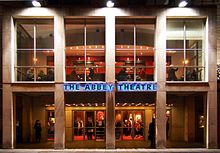User:TESTJP/sandbox
Career[edit]
George Fitzmaurice’s first important success was in 1907, with an Abbey Theatre production of his comedy “The Country Dressmaker”. One of Fitzmaurice’s most famous characters was Luke Quilter, “The man from the mountain”.[1] This character appears in this play that proved to be greatly favored with his audience, to the surprise of W.B. Yeats.[1] Due to the commercial success of The “Country Dressmaker”, it brought necessary income to the Abbey Theatre in 1907.[1]
George Fitzmaurice’s second play was a dramatic fantasy called “The Pie Dish”. It was heavily rejected and slated by critics and considered blasphemous.[1] Due to the success of “the Pie Dish”, it has led to the rejection of another of his plays called “The Dandy Dolls”. “The Dandy Dolls” is now understood as another of his best plays which was another dramatic fantasy“ and was produced in the Abbey Theatre in 1969 which was six years after he died.[1][2] The Abbey Theatre was established as a national theater for Ireland by W.B. Yeats and Woman Gregory in 1904. These progressives characterized the aspiration of the Convent Theater with their declaration “to bring upon the stage the deeper emotions of Ireland”.[3]
“The Country Dressmaker” was broadcast on Radio Éireann Players, During his lifetime, some of his dramatic works were produced by poet Austin Clarke in Lyric Theatre, Dublin.[2] In 1923 his play called “Twixt by Giltinans and the Carmodys” was also performed on Abbey Theatre and eight more of his plays were printed in the literary journey The Dublin Magazine from 1924-195.[2]“The Dandy Dolls” reminded us of the zest and tang of his language, the breadth of his imagination and his mastery of concentrated theatrical form in which the verbal and the visual engage in a fandango of terror and delight. He left behind the most heart-rending legacy in Irish literacy history.[3]
Later Life and Death[edit]
“George Fitzmaurice increasingly became reclusive as time passed”.[2] Fitzmaurice fought in World War One. With a fear of travelling and people or crowds, he spent his later years following “monotonous routines in Dublin”.[1] In 1963, Fitzmaurice died penniless at his own home at No.3 Harcourt Street and was buried in Mount Jerome cemetery.[2]
"The works of George Fitzmaurice are now undergoing something of a revival.”[2] A fellow Kerry playwright, John B Keane says that he is starting to be recognized as the great dramatist he truly was. He also describes his work as having “Practical clarity of speech coupled with a great conciseness, and a tightness in his writing and in his construction.” [2]
A Man from Daugh, Michael Connor currently owns land that once belonged to the Fitzmaurice family, He often saw Fitzmaurice in the town after his retirement from the civil service but by that time the dramatist had completely lost interest in seeing his own plays on the stage.[2]
In Howard K. Slaughter’s book “George Fitzmaurice and His enchanted Land”[4] says “In Fitzmaurice’s room were no pictures of himself, few personal mementos, but he did have a copy of almost every play he had published, as well as the few in draft forms no one knew of. Besides his personal clothing, there was little else.”[4]
He also died without a leaving will.[5] There would be stories of him in newspapers but not actually photos and there aren't any images of him in the “Abbey scrapbook”. [5]
In acknowledgement to his abilities as a national play writer, The people from Daugh created “The George Fitzmaurice library” in their town and on October 14th 1995, a headstone that was sculpted by a local and commissioned by the Historical Society, was placed over George Fitzmaurice’s grave as a sign of recognition.[5]

Reference[edit]
- ^ a b c d e f Kerry Writers Museum. n.d. George Fitzmaurice - Kerry Writers Museum. [online] Available at: <https://www.kerrywritersmuseum.com/george-fitzmaurice/> [Accessed 19 November 2020]..
- ^ a b c d e f g h RTÉ Archives. n.d. George Fitzmaurice Kerry Writer. [online] Available at: <https://www.rte.ie/archives/2020/0727/1155819-george-fitzmaurice-kerry-writer/> [Accessed 19 November 2020].
- ^ a b Brennan, F., 2005. George Fitzmaurice: “Wild In His Own Way” Biography Of An Abbey Playwright. Dublin, Ireland: The Arts Council.
- ^ a b Slaughter, Howard K. (1972). George Fitzmaurice and his enchanted land. Dublin: Dolmen Press. ISBN 0-85105-199-5. OCLC 812983.
- ^ a b c Gokerry.ie. n.d. George Fitzmaurice (1877-1963) Playwright. [online] Available at: <http://www.gokerry.ie/index.php?action=locations&location_id=54&page_id=479> [Accessed 20 November 2020].
